AMD Midrange Gaming
Let's start by pointing out the pink elephant hiding in the corner: there's no doubt that Intel has faster processors than anything AMD is currently shipping. Intel also has CPUs that overclock (percentage wise) a lot better than anything AMD currently offers. So why even bother considering AMD? There are several reasons. Price is the biggest attraction, which extends beyond the price of the CPU to the price of the platform as a whole. The other major consideration is that if you're talking about a gaming system, for the vast majority of systems the graphics card is going to be the most important aspect of gaming performance. The features you can get at a particular price point for an AMD setup are also very good. Now that that's out of the way....
| AMD Midrange Gaming System |
| Hardware |
Component |
Price |
Rebates |
| Processor |
Athlon 64 X2 5000+ AM2 Black Edition (2.6GHz 2x512K unlocked) - Retail |
$130 |
|
| Motherboard |
ASUS M2N32-SLI Deluxe WiFi (nForce 590 SLI) |
$167 |
|
| Memory |
Patriot Extreme Performance 2x1GB PC2-8500 (PDC22G8500ELK) |
$139 |
$25 |
| Video Card |
XFX GeForce 8800GTS 320MB (PVT80GGHF4) |
$287 |
$20 |
| Hard Drive |
Western Digital Caviar SE16 320GB 7200RPM 16MB (WD3200AAKS) |
$80 |
|
| Optical Drive |
Samsung 20X DVD+R SATA (SH-S203B) |
$36 |
|
| Case |
Cooler Master Centurion 534 (RC-534-KKN2-GP) |
$66 |
$10 |
| Power Supply |
Corsair CMPSU-520HX |
$108 |
$10 |
| Display |
Acer AL2216Wbd 22" 5ms (1680x1050) |
$235 |
|
| Speakers |
Logitech X-530 5.1 70W Speakers |
$66 |
|
| Keyboard |
Saitek Eclipse USB Wired (PZ30AU) |
$40 |
|
| Mouse |
Logitech G5 Wired Adjustable Weight |
$52 |
$15 |
| Operating System |
Windows Vista Home Premium 32-bit (OEM) |
$105 |
|
| Bottom Line |
$1511 |
$1431 |
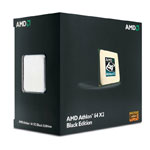 |
The core of any system is the motherboard and processor, and we've gone with AMD's latest X2 5000+ Black Edition sitting snugly in an ASUS M2N32-SLI Deluxe WiFi motherboard. The Black Edition's claim to fame of course is its unlocked multiplier, giving overclockers a little bit more flexibility. We've seen reports online of people hitting 3.4 GHz and beyond with a bit of effort. While just about any midrange Core 2 Duo processor will offer better performance at maximum stable overclock, the X2 5000+ is still relatively inexpensive and offers competitive stock performance. If you don't care about the unlocked multiplier, a regular X2 5000+ costs $10 less.
If you're undecided on what CPU or platform might be best, you might want to take a look at our
Midrange CPU Roundup from a couple weeks back. As long as you're willing to take overclocking out of the picture, you can get performance that's relatively competitive with Intel's Core 2 Duo E4400/E4500 with a CPU price that's nearly identical to the E4400 - or about $13 cheaper if you get the standard 5000+. Looking specifically at the gaming results from that article, performance tends to fall between those same two processors, at least at 1024x768 where we aren't GPU limited. If you're like most people and you plan to play at higher resolutions (for example 1680x1050 if you purchase the recommended LCD), performance differences are going to be even smaller.
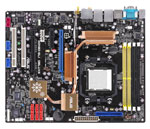 |
The ASUS motherboard offers SLI support, which might be something useful in the future, but for a midrange system we're going to stick with single graphics cards for now. The ASUS M2N32 Deluxe WiFi also comes with a bevy of overclocking options, ASUS' proven reputation, and integrated 802.11b/g WiFi support for good measure. If you will make use of all of these features, the final price is very good; if you don't need WiFi or dual x16 PEG slots, you can get basically the same performance and features for around $95 with the DFI Infinity NF570-M2/G.
As mentioned, the graphics card is probably the most important component for this type of system, and we had quite a few choices. We decided to go with a GeForce 8800 GTS 320MB, as it offers the most attractive price/performance ratio. Other than minor differences in factory clock speeds, all of the 8800 GTS cards are pretty similar, so the deciding factor was price. XFX ended up getting the nod, but EVGA, Gigabyte, Leadtek, and others are not too far off.
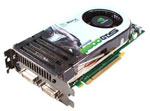 |
It's important to point out the runner-up cards that we didn't choose as well, as other factors might actually make them a better choice in the long-run. The 8800 GTS 320MB performs identically to the 640MB version, up until the point where you run out of graphics memory. Right now, that usually only happens at extreme resolutions like 2560x1600 or in a few certain games with maximum texture quality (which often doesn't bring a noticeable improvement in visual quality). That's right now, however; next-generation games could very likely push 320MB cards to the limit, particularly when we consider that 512MB cards have been shipping for a couple of years now. We have seen preliminary results on next-gen titles where the 640MB cards hold a pretty substantial performance advantage, so if you can spare the extra money that's probably the safer bet.
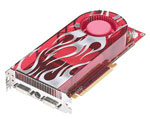 |
The other option is AMD's recently launched HD 2900 Pro, which in theory carries a similar price to the 8800 GTS 320MB. The drawback here is that the cards aren't readily available right now, and while this is an AMD platform we're using an NVIDIA chipset. MSRP is supposed to be around $250, but the few places that even have cards in stock are charging a price premium. Since the cards seem to be downclocked 2900 XT GPUs, you can probably get some pretty good overclocking results, but many people are simply interested in stock performance. You also get a $20 mail-in rebate on the GTS 320MB, and HD 2900 cards tend to really suffer when antialiasing is enabled. Finally, AMD and NVIDIA both have upcoming midrange cards that could very well improve performance while staying under the $250 price point; since these cards are not yet available, however, they will have to wait for a future Buyers' Guide.
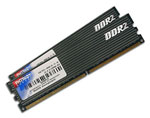 |
We're not going to spend a lot of time dwelling on the rest of the components, as many of them have been discussed in previous Buyers' Guides and/or reviews. We did choose to use some DDR2-1066 memory, which honestly might be overkill considering the price. $114 (after rebate) for 2GB of this type of memory might seem like a steal compared to a year ago, but if you're okay with DDR2-800 you can still pick up 2GB of 4-4-4 memory for a measly $75. In fact, one of the AnandTech editors did exactly that just this last week... twice! If you're thinking about upgrading to a 64-bit operating system, give some serious thought to running a 4GB configuration with DDR2-800 as opposed to 2GB of higher performance DDR2-1066.
The final price comes out to $1511 (not counting rebates). Depending on how you want to configure things, going with an AMD platform will save you somewhere between $15 and $100 compared to a similar Intel configuration. By no means is our AMD platform bad, but if we were to go out and purchase a midrange gaming system right now, it would be using a Core 2 Duo processor. Then again, we're enthusiasts, so overclocking is pretty much a given. If you can hold on a couple more months, we're definitely interested in some of the changes that will occur with AMD's upcoming product launches. The attraction of current AM2 systems is mostly price, and the gap there is really too small these days to make it a real deciding factor.















41 Comments
View All Comments
BigLan - Monday, October 15, 2007 - link
Thanks for noting that the kworld tuner could be a real POS. Personally, I'd stay far, far away from it if at all possible - pcalchemy have a white box avermedia combo for $80 which would be a better bet. I'd also recommend the hauppauge 1600 or 1800 for the main tuner - they're about $90-100, and can sometimes be found at ~$80 with a rebate at circuitcity or compusa.I'd also think about going for 2 500gb drives @ $110 each (total $220) rather than one 750gb one @ $200. It'll give you 33% more capacity for 10% more money, but it is another drive in the case adding to the heat and noise.
The analog tv situation doesn't really apply to cable-fed viewers either as cable providers will continue offering analog sdtv for a period of time after the ota transmissions are turned off (I think it was 2012 at the earliest.) You can also continue to use the svid input to capture SD channels from a set-top box even after that date. The 2009 switch off only applies if you're using an antenna for your sd channels.
JarredWalton - Tuesday, October 16, 2007 - link
I can't speak from personal experience about most of the TV tuner cards out there, but I have looked at QAM tuners in the past and they were at best very time consuming to get configured. Still, I also have an AVerMedia dual tuner (non-QAM) installed in my own HTPC that works very well for analog channels (courtesy of a Comcast feed). Quality probably isn't as good as an ATI Theater 550 that I have, but analog TV quality is already lousy anyway.I currently use FireWire to capture HDTV content when I feel the need -- for example, I recorded the women's World Cup soccer matches since they were taking place at 3 and 5 a.m. usually. For one-time recordings like that, FireWire was enough. Unfortunately, that doesn't allow you to watch one channel and record another. Setting up recordings is also not nearly as user-friendly as using a Media Center interface.
One of the problems with using dual hard drives is that Windows Media Center doesn't worked as well in that situation (in my experience) unless you're running a RAID 0 array. All of the recordings are sent to one specific drive/folder, so you would have to manually transfer movies between hard drives. RAID 0 certainly is an option, but I'm pretty much okay with using a single larger hard drive in most situations. Besides, you could then upgrade capacity further in the future if necessary.
Obviously, there's no correct answer to which choice is best -- I say po-tay-to, you say po-tah-to. LOL
drpepper128 - Monday, October 15, 2007 - link
In your article you said that you would probably receive a lot of criticism for your choices, well I’m hear to make one. Your choice of memory seems to coincide with what you always choose in your systems. You chose a lower capacity, but faster timing for both gaming rigs. I thought it was proven a while ago that those types don’t really add much to performance, at least not as much as capacity does. I know however that you do include over clocking into your considerations, but is using the better timings and faster speeds really not needed? I personally would take the Intel setup and choose a the E4500 with slower higher capacity memory and over clock that way; however, I haven’t had much experience with the new 1333Mhz FSB Intel processors and their over clocking capabilities.One problem with using the higher memory capacity I stated above is the windows 64bit problem. I noticed you tackled this in your article on the workstation part, but is it worth it? I’m currently about to build a friend a system and was quite interested in the answer. I do know that a 32bit operating system has a limit around 2 or 3 gigabytes, but doesn’t a 64bit operating system also take up twice as much memory for each application essentially turning your 4GB of memory into only 2? Is it really worth spending the extra money on 4GB of RAM to future proof your system?
Does anybody know when the HD 2900 Pro will start coming out in mass? I’ve been thinking it will be a good buy when it comes down in price.
Finally, Anandtech, I miss the old style guides where you listed several parts using your price grabber and then recommended the best parts. I’m currently finding the best motherboards to use for builds through Newegg votes and forum posts. You do make several reviews on these boards, but they have been lacking lately, and it is hard to put all the motherboards in to focus and select the best one.
Thank you for your great article,
drpepper128
Calin - Tuesday, October 16, 2007 - link
I don't think going over 2GB is so important on a budget PC. Anyway, using 2x1GB allows one to buy two other DIMMs to increase the memory - so you buy 2 DIMMs now for 2GB and maybe later another 2GB for a 6GB totalleexgx - Friday, October 19, 2007 - link
most small mother boards Only have 2 slots for ramJarredWalton - Friday, October 19, 2007 - link
What reality do you live in? Even most uATX boards now have four DIMM slots. Only the absolute cheapest/smallest mobos have two slots these days.JarredWalton - Monday, October 15, 2007 - link
It previously seemed like most people would simply read one or two of the pages anyway, focus on the tables, and skip everything else. I figured just cutting to the chase would allow me to write less text and focus on the important stuff. I try to expound on areas that do matter (motherboards, GPU options) and not worry too much about stuff that most people will breeze over (case, keyboard, mouse, speakers).For the memory, note also what I said on the AMD setup: "We did choose to use some DDR2-1066 memory, which honestly might be overkill considering the price. $114 (after rebate) for 2GB of this type of memory might seem like a steel compared to a year ago, but if you're okay with DDR2-800 you can still pick up 2GB of 4-4-4 memory for a measly $75. In fact, one of the AnandTech editors did exactly that just this last week... twice! If you're thinking about upgrading to a 64-bit operating system, give some serious thought to running a 4GB configuration with DDR2-800 as opposed to 2GB of higher performance DDR2-1066." I think the Intel side would benefit more (i.e. for overclocking), but having good quality RAM is never a bad thing IMO. I'm not going to bother with DDR3 recommendations, but $40 for more flexibility in overclocking and such is reasonable.
Those of us who are running Vista 64-bit have now reached the point where compatibility issues are pretty much gone (at least, so I heard from Gary). I'm still running XP on my primary rig, but I keep looking at one of my Vista PCs and thinking it may finally be time to give it a serious shot. If I had a 64-bit version of Photoshop and perhaps some games that benefited, I think I'd make the switch.
Concerning memory footprints on x64, it's only certain instructions (memory addresses) that are twice as large. Most opcodes are still 32-bit and most data is still 32-bit. 64-bit OS/apps do use more memory overall, but it's nowhere near twice as much. 4GB and 64-bit is still going to be more roomy than 2GB and 32-bit.
Hope that helps.
Pirks - Tuesday, October 16, 2007 - link
No, it is not. You pay like 40% more while getting maybe 5% back in terms of performance. How can it be reasonable? RAM overclocking and paying 500% (THAT'S FREAKIN FIVE TIMES!) of a normal price to get those precious 10% in performance gain, when you install exotic duper expensive ddr2-1066? You gottabekiddin'!JarredWalton - Tuesday, October 16, 2007 - link
5% at stock performance. If you push DDR2-800 and DDR2-1066 to their limits with overclocking, stability on the DDR2-1066 modules is better and performance gains generally reach into the 15-20% difference range. Again, I have stated in the text that it isn't required or even necessary. If you have no intention of overclocking, grab DDR2-800 4-4-4 memory and save yourself $40.Consider this, however: $40 more on a $1500 system represents a total cost increase of 3% for what you admit is probably a 5% performance increase. $75 will get you an 8800 GTS 640MB, which will add anywhere from 0% to 25% depending on game, resolution, and detail settings. And yet many also question the listing of a 320MB part over a 640MB part as being just as unreasonable. That's why both alternatives are discussed in the article.
leexgx - Friday, October 19, 2007 - link
overclocking ram at best is 1% (or 10 FPS thats when thay are at 150FPS range)been shown loads of times about ram speeds tested and tryed
id not pick any thing less then an 8800 640MB GTS but most users do not tweek there in game settings to higher ones so not be an problem still an Very fast card